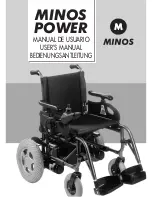
55
8
8.3. Characteristics and Handling of the Lithium Ion
Battery (ESB1)
(1)
Ambient temperatures
Depending on the ambient temperature, the distance that can be traveled becomes shortened.
In order to maximize the battery’s performance, it is recommended that you use the battery under
the following conditions.
When in use on the wheelchair:
Temperature range between 0 to 35°C (32 to 95 °F)
When removed from wheelchair and stored:
Temperature range between 10 to 25°C (50 to 77 °F)
When charging:
Temperature range between 10 to 25°C (50 to 77 °F)
• Storing the battery in excessively high or low
temperatures will speed up its degradation, and its
capacity will rapidly decrease.
• U s i n g t h e w h e e l c h a i r i n e x c e s s i v e l y l o w
temperatures will cause the battery deterioration
to speed up and its capacity to rapidly decrease.
For information on degradation, see “Battery’s
deterioration characteristics” on the next page.
While traveling, if the internal temperature of the lithium ion battery becomes too
high or too low, a buzzer will notify you.
• When using a lithium ion battery, a buzzer will beep (continuous Pi Pi Pi Pi) if the
battery’s internal temperature drops to 0°C (32°F)or below, or rises to 45°C (113 °F) or
above for 5 seconds.
• When the buzzer beeps, promptly return to the environment within the recommended
range of operational temperatures, and use the battery there.
• When descending down a slope on the wheelchair, the drive motor, contrary to normal
operation, generates electricity and charges the battery. Charging a lithium ion battery
when its temperature is 0°C (32 °F) or below/45°C (113 °F) or above causes its
deterioration to progress extremely rapidly. For this reason, when you are descending
down a slope in such temperatures, the wheelchair may stop moving to protect the
battery.
When this happens, you will hear 5 long beeps before the wheelchair stops, and then
another long beep 10 seconds later as the wheelchair stops.
TIP
















































